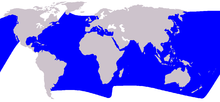Striped Dolphin
| Striped dolphin | |
|---|---|
 |
|
| A striped dolphin in full flight | |
 |
|
| Size compared to an average human | |
| Scientific classification | |
| Kingdom: | Animalia |
| Phylum: | Chordata |
| Class: | Mammalia |
| Order: | Artiodactyla |
| Infraorder: | Cetacea |
| Family: | Delphinidae |
| Genus: | Stenella |
| Species: | S. coeruleoalba |
| Binomial name | |
|
Stenella coeruleoalba (Meyen, 1833) |
|
 |
|
| Striped dolphin range | |
The striped dolphin (Stenella coeruleoalba) is an extensively studied dolphin found in temperate and tropical waters of all the world's oceans. It is a member of the oceanic dolphin family, Delphinidae.
The striped dolphin is one of five species traditionally included in the genus Stenella; however, recent genetic work by LeDuc et al. (1999) indicates Stenella, as traditionally conceived, is not a natural group. According to that study, the closest relatives of the striped dolphin are the Clymene dolphin, the common dolphins, the Atlantic spotted dolphin, and "Tursiops" aduncus, which was formerly considered a subspecies of the bottlenose dolphin. The striped dolphin was described by Franz Meyen in 1833. The specific name coeruleoalba (from Latin caeruleus 'dark blue' and albus 'white') refers to the characteristic blue and white stripes on the flanks.
The striped dolphin has a similar size and shape to several other dolphins that inhabit the waters it does (see pantropical spotted dolphin, Atlantic spotted dolphin, Clymene dolphin). However, its colouring is very different and makes it relatively easy to notice at sea. The underside is blue, white, or pink. One or two black bands circle the eyes, and then run across the back, to the flipper. These bands widen to the width of the flipper which are the same size. Two further black stripes run from behind the ear — one is short and ends just above the flipper. The other is longer and thickens along the flanks until it curves down under the belly just prior to the tail stock. Above these stripes, the dolphin's flanks are coloured light blue or grey. All appendages are black, as well. At birth, individuals weigh about 10 kg (22 lb) and are up to a meter (3 feet) long. By adulthood, they have grown to 2.4 m (8 ft) (females) or 2.6 m (8.5 ft) (males) and weigh 150 kg (330 lb) (female) or 160 kg (352 lb) (male). Research suggested sexual maturity was reached at 12 years in Mediterranean females and in the Pacific at between seven and 9 years. Longevity is about 55–60 years. Gestation lasts about 12 months, with a three- or four-year gap between calving.
...
Wikipedia

